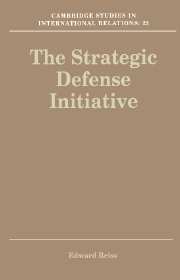Book contents
4 - Contexts
Published online by Cambridge University Press: 18 December 2009
Summary
Between 1983 and 1985, SDI was established and came to be the Pentagon's largest single research and development (R&D) programme. Part 2 examines the different rationales given for SDI; how the programme was established and shaped; and why it flourished, despite fierce criticism from senior scientists and statesmen. After summarising the development of SDI during this period, it analyses the role of interest groups, which, since funds were expanding rapidly, had little need to fight among themselves to shape the details of the programme. The emphasis is therefore more on how the interest groups worked together to establish the programme as a whole.
Following the President's speech, plans for a renewed BMD programme were formulated. Official advisory panels (the Fletcher, Hoffman and Miller panels), which completed their reports in October 1983, gave qualified support to Reagan's idea. It was christened the ‘Strategic Defense Initiative’ by National Security Decision Directive 119 (NSDD–119), signed on 6 January 1984. The SDI Office (SDIO) was established in April 1984, based in Washington, D.C. and headed by Lt- Gen. James A. Abrahamson.
The Administration's first SDI budget submission to Congress, made on 1 February 1984, requested $2,001 billion for SDI in FY 1985. On 12 October 1984, Congress authorised a total of $1,621 billion, of which the Department of Energy took $224 million. The new SDI programme comprised five main Program Elements (PEs), each defined according to its stated aim. These PEs were created for military service and defence agency programmes.
- Type
- Chapter
- Information
- The Strategic Defense Initiative , pp. 51 - 59Publisher: Cambridge University PressPrint publication year: 1992

